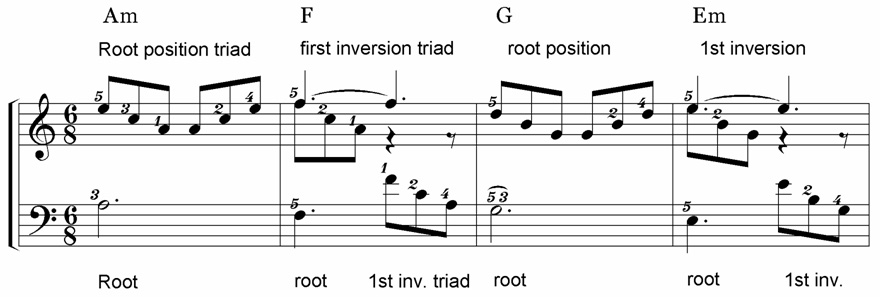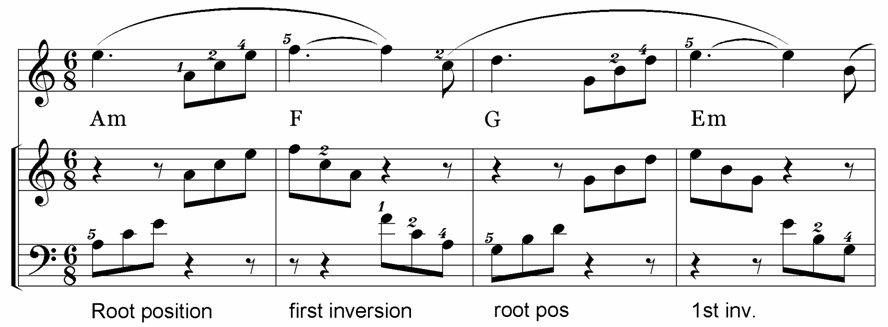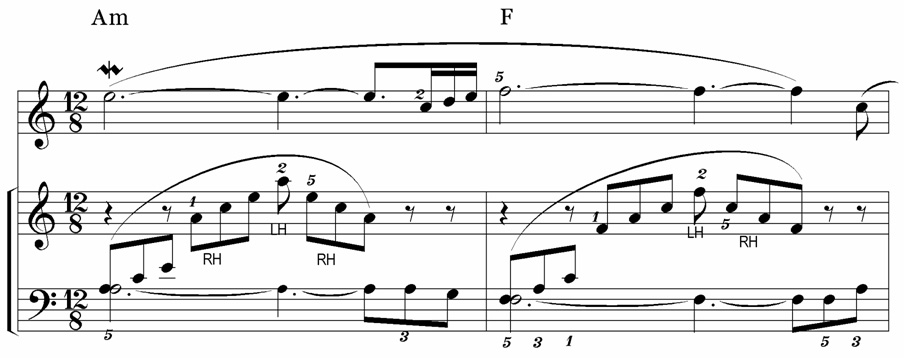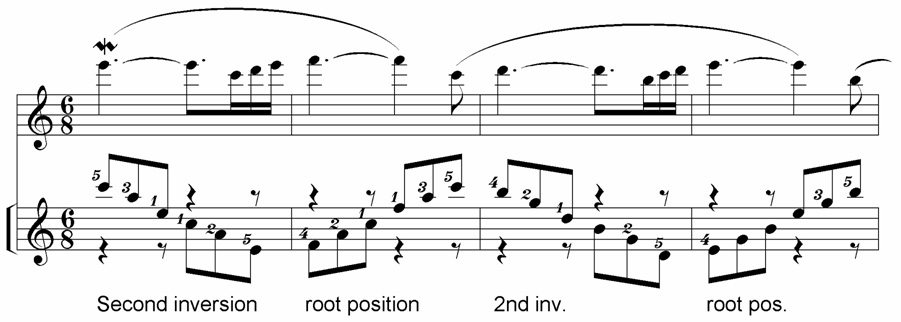Patreon MUSICARTA Premium
Pyramids Variations
Further Variations
The Pyramids Variations keyboard creativity course shows how elements like the melody line, the bass line, the triad-based accompaniment and the rhythm can be varied and combined to create new versions of Pyramids. The additional variations in this section show some more possibilities.
Method
Starting an accompaniment pattern and keeping it going all the way through a chord sequence is a valuable part of the accomplished keyboard player’s skills.
A teacher working with a more advanced pupil (or a mature student working alone) could study just the first line of any of the variations in this lesson, work out what pattern they are built on, and try to complete the variation by playing the rest of the chord sequence in that pattern.
It isn’t suggested that you instantly improvise arrangements, but rather work arrangements up over time, modifying ideas in whole or in part according to the possibilities and limitations and what ‘sounds right’.
Mixed inversions in six-eight
This relatively simple variation is a supplement to the Mixed Inversions module. It is ideally suited to the ‘method’ described at the start of this section and to a simple bass-line 'circle of fifths' treatment.

Melody over rising and falling inversions
This variation has already been presented on page 103 XXX, but here it is written out on three staves. Sheet music often presents melodies-plus-accompaniment like this.
This way of presenting the variation shows more obviously how the melody is added onto the accompaniment pattern. It also models the skill of the keyboard player who is meeting the challenge of playing a melody while keeping a rhythmic accompaniment with a regular pattern going. Playing from this arrangement is useful even if you have already played the previous version.

Developed melody with developed bass line
This variation adds the developed bass line to the six-eight developed melody version and could be attempted as a continuation of the Developing the Bass Line material. Only the two extra bass line approach notes in each bar are new.

Melody in the left hand
Playing the melody in the left hand is an obvious way of getting more out of familiar material. You will benefit from painstaking counting and together, left, right (TLR) analysis. See the ‘Mixed inversions in four-four with syncopation’ variation in this section for a fully worked-out example of counting and TLR analysis.

There are more melody-in-the-left-hand variations on the Diaries Overview page - TPVD 17-04-16: In Three-Four, LH Melody (MMYT) and TPVD 08-04-16 (MMYT).
Playing the melody in the left hand can be a real brain-teaser, but often the left hand brings a different character to a melody. From a music-development point of view, it's well worth the trouble.
There's a melody-in-the-left-hand version of the 'chopping chords' variation below, too.
Melody plus LH-over patterns plus developed bass line
This variation combines the developed melody with 12-note left-hand-over patterns and the developed bass line. The melody sits inside the LH-over patterns, which run both below and above it.
The variation is shown on three staves; the task is to play all three lines of music at once. The stems-down developed bass line can be left out to simplify the task and added later.

Melody over falling-then-rising inversions
This variation combines the melody and a new accompaniment pattern consisting of falling then rising triads, incorporating second inversion triads for the first time.
Both the left and right hand triads are shown on the lower stave, the right hand stems up and the left stems down. The fingering given is for rehearsing the falling-then-rising inversions only, and has to be changed to incorporate the melody (also played with the right hand.

Mixed inversions in four-four with syncopation
This variation shows how material in the more classical six eight rhythm can be adapted into the ‘rockier’ four-four rhythm.
The rhythm of the left hand is a rock staple. Together, left, right analysis will help. Always let yourself abandon the rhythm temporarily while drilling the TLR ‘sequence of events’.

Suspensions and syncopation in four-four
This variation is again set out in a way which models a good keyboard player’s thought processes and skills.
The variation is presented in skeletal form, as it exists in the creator’s mind, first. The first line of the ‘realisation’ (the playing-out of the version) is very simple, but developments of the melodic line created by the suspensions and resolutions soon follow. Count the left hand rhythms carefully.

Left-hand Chopping Chords
With the video, you won't need music for this simple variation, but it's good practice for keeping a rhythm.
The first time through, the left hand plays root position triads.
The second time, it mixes root position and first inversion chords.
Here's a 'chopping chords' version with the tune in the left hand. The rhythm of the chords is slightly different.
The melody-in-the-left-hand version uses right hand first inversion-second inversion chord pairs. For example, A minor 1st inv, followed by F maj 2nd inv - closest inversion pairs (only one note changes).
You need some space between the hands to make it work. Try it!
Pyramids with a Fuller Left Hand
These two variations have more chord tones in the left hand. Like the 'chopping chords' variation, the first one uses only root position chords, and the second one mixed root position-first inversion chords.
First variation

Second variation

No more sheet music than these two examples here, which show the repeating pattern. Copy the endings and put them in your list of options.
Next, go on to the Diaries Overview and Diaries and More Variations section.
|
OUT NOW! |
THE MUSICARTA BEAT & RHYTHM WORKBOOK At last! An effective approach to keyboard rhythm & syncopation skills. Learn more! |
ONLY $24.95! |
PATREON
|
The MusicartaA methodical approach to keyboard syncopation for
|
PUBLICATIONS
exciting keyboard
creativity courses
CHORDS 101
WORKBOOK

~HANON~
video course

Musicarta
Patreon
PENTATONICS
WORKBOOK
video course

Creative Keyboard
video course

BEAT AND RHYTHM
WORKBOOK

- Volume 1 -

12-BAR PIANO
STYLES WORKBOOK

MUSICARTA MODES
WORKBOOK

PIANO STYLE

CANON PROJECT
video course

VARIATIONS
video course


- Piano Solo -
video course

- Piano Solo -


YouTube playlists





 THE LOGO
THE LOGO
